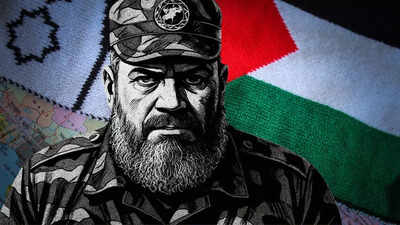
Gaza’s war-scarred labyrinth has a new face of command. His name is Ezzedin al-Haddad—and most people have never heard of him.After more than 600 days of war, and the deaths of both Yahya and Mohammed Sinwar, Hamas has quietly handed over its Gaza operations to a shadowy veteran commander known as The Ghost of al-Qassam.
At 55, Ezzedin al-Haddad is no stranger to bloodshed, nor to survival. With a $750,000 Israeli bounty on his head and the weight of a crumbling militant empire on his shoulders, Haddad steps in as Hamas’s third Gaza chief in just seven months.
From the Tunnels to the Top
An experienced field commander and tactician, Haddad played a key role in planning the devastating October 7, 2023 attacks that sparked the current war. According to Arab and Israeli officials, he has also overseen the recruitment of new fighters and taken personal responsibility for the Israeli hostages still held in Gaza—keeping photos of them on his phone, even engaging directly with some in captivity.But he didn’t exactly rise to the top through a hotly contested election. The war has decimated Hamas’s top ranks. Of the 18 senior figures on the group’s military council before the war, only a few are thought to still be alive. Mohammed Sinwar, Haddad’s immediate predecessor and Yahya’s younger brother, was killed in May during an Israeli strike beneath Khan Younis’s European Hospital. Haddad survived—and took over.
A Ghost with a Memory and a Grudge
Unlike the flamboyant Sinwar brothers, Haddad is known for his silence and shadowy demeanour. His nickname, The Ghost of al-Qassam, reflects a career defined by evasion and low visibility. He has survived several Israeli assassination attempts, but not without personal loss: both of his sons have been killed in the current conflict.A former hostage who met Haddad five times during captivity described him as calm, cold, and Hebrew-speaking.
On one occasion, Haddad even ordered that a book left behind by a hostage be returned to him. But the ghost has moods too. In later meetings, he became harsher and more bitter—changes that coincided with the death of his son.
A Diminished but Not Defeated Hamas
While Israel claims to have killed up to 20,000 of Hamas’s 35,000 fighters and destroyed most of its weapons stockpile, the group remains Gaza’s dominant armed force. Its ranks have been replenished—at least numerically—with thousands of young recruits trained with little more than leaflets or crash courses in ambush tactics.Israeli and Arab intelligence sources estimate Hamas now commands around 25,000 fighters, though many are poorly trained and under-equipped. The group's financial reserves have also dwindled. Once flush with income from taxing aid and smuggling contraband, Hamas is reportedly struggling to pay its fighters. According to an internal document found by the Israeli military, Hamas reduced the share of aid diverted to its military wing from 25% in early 2024 to just 7% by April.Still, the organisation has retained one of its most potent strategic advantages: its underground network. Israeli military sources concede that as much as 75% of Hamas’s tunnels remain intact. And as recent Israeli casualties show, the group is turning unexploded ordnance into makeshift bombs capable of ambushing even well-armoured patrols.
A Fighter Willing to Talk?
Despite his militant past, Haddad is reportedly more pragmatic than his predecessors.
Arab intelligence officials say he pushed for the January 2024 hostage-prisoner swap and urged further releases to extend the ceasefire, which eventually broke down in March. He has also shown tentative openness to discussing the disarmament of Hamas—something the Sinwar brothers firmly rejected.But pragmatism has limits. Haddad still insists that no further hostages will be released without a full Israeli withdrawal and an end to the war.
His motivations, officials believe, are driven as much by strategic calculation as ideology: Hamas remains Gaza’s only coherent armed authority, but it is bleeding fighters, funds, and territory.
What Comes Next?
Israel aims to control 75% of Gaza by late July. Its current strategy seeks to fragment Hamas’s hold on the enclave by isolating population centres and targeting remaining leadership. But for every commander killed, another emerges.
And while the group may now rely on improvised explosives rather than rockets, its capacity to inflict daily pain on Israeli forces persists.As Miri Eisin, former deputy head of Israeli combat intelligence, put it: “They don’t need tens of thousands of weapons. They just need to kill a soldier a day.”Whether Haddad can—or wants to—shift the trajectory of the war remains unclear. He is a commander forged in tunnels and blood, tempered by loss, and now facing a military juggernaut in a battle that seems increasingly existential. But so far, the Ghost has not disappeared.

 1 day ago
45
1 day ago
45




























 English (US)
English (US)